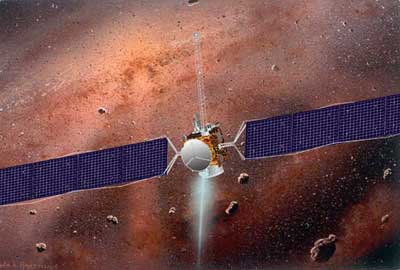While most objects in the asteroid belt are nothing more than lumps of rock, a collection of material from various bodies, Vesta and Ceres have remained virtually unchanged from the time they formed about 4.6 billion years ago. Chapters from the early history of the solar system can be written on their surface.
Avi Blizovsky
Direct link to this page: https://www.hayadan.org.il/dawn100305.html
It is called Dawn, and in a little over a year, this spacecraft will take off from Florida towards two large asteroids - Vesta and Ceres. These are the two largest asteroids in the solar system in an ambitious journey, perhaps one of the most complex and dangerous ever undertaken. This is reported by the website Universe Today, the American equivalent of the science website, which relies mainly on press releases from the various research institutions.
Dawn will bring a suite of scientific instruments to both asteroids and will act as a time machine to help scientists understand what our solar system looked like 4.6 billion years ago
Both asteroids are in the main asteroid belt, but that's where their similarities end. Vesta formed closer to the Sun, and probably shares many properties with the inner planets. The scientists believe that it was formed in a hot and dry environment and probably has layers of volcanic ash and a solid metallic core. But even the best images from the Hubble Space Telescope showed a fuzzy gray world, adding more questions than answers. Vesta is the brightest asteroid in the solar system and its diameter is about 530 km. It can sometimes be seen with the naked eye. In fact it is the only asteroid from the main asteroid belt that can be seen. "Lusta's journey may be a little dangerous. We know very little about Vesta's internal structure," explains the chief engineer of the operation, Dr. Mark Reiman. "He is unpredictable and almost certainly has an irregular attraction field.
A little far from it, across an invisible band between the inner rocky planets and the outer gas giants, resides Ceres, the largest asteroid in the solar system, with a diameter of 957 km. Unlike Vesta, Ceres formed in a cold and wet environment, and in the presence of water. This water is probably still there, in the form of ice caps, a thin atmosphere consisting mainly of water vapor or even underground liquid water.
While most objects in the asteroid belt are nothing more than lumps of rock, a collection of material from various bodies, Vesta and Ceres have remained virtually unchanged from the time they formed about 4.6 billion years ago. Chapters from the early history of the solar system can be written on their surface.
The $370 million Dawn spacecraft is scheduled for launch in June 2006, and after a 4-5 year journey (depending on whether it makes a flyby or not) will arrive at Lusta in 2010 or 2011, exploring it for nearly a year before taking off for a three-year rendezvous with Ceres. Then. The spacecraft will contain a suite of scientific instruments designed to study these two asteroids in detail: their masses, volume, rate of self-rotation, chemical components and the distribution of their elements and their gravity, and of course - the spacecraft will also take spectacular photos.
Dawn will be the first spacecraft ever to attack two different bodies in the solar system (not including, of course, orbiting the Earth). This step would not have been possible without an ion engine, similar to the one that assisted the Deep Space 1 spacecraft that set distance and speed records and served as a model for the development of Dawn. The spacecraft uses electricity generated from the sun to ionize xenon atoms and accelerate them through the back of the spacecraft. The thrust is tiny but economical on fuel, and the engine can run for months or even years and deliver enormous speeds.
An ion engine also provides flexibility: "It gives us a very long launch window. We will launch in 2006 because that is when the spacecraft will be ready, but we will still be able to carry out the mission even if there is a delay until November and even beyond that," said Dr. Reiman. So far, construction continues as a series. The completed spacecraft will be sent this week from NASA's Jet Propulsion Laboratory to Orbital Sciences for the next assembly phase.
Dr. Reiman will make sure to update us in real time, as he did when he managed the Deep Space 1 spacecraft operation, in the blog he started. "These missions do not belong only to NASA or the USA, they are our messengers to the universe, and we want everyone to travel with us on the journey." Rayman explained that he also announced that the blog will start during development.
.
For news in Universe Today, a website based on press releases

